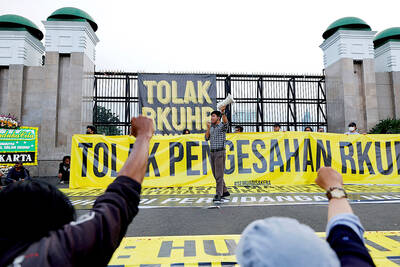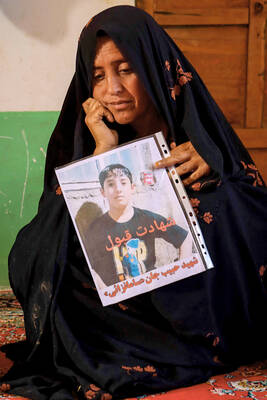Typhoon Koppu made landfall in China, bringing winds as high as 139kph, after passing to the south of Hong Kong, where 58 people were injured and offices and schools closed for the morning.
Koppu crossed the coast of southern China near the city of Taishan a little before 8am local time, the Hong Kong Observatory said in a bulletin. The center of Koppu was 300km west of Hong Kong at 12pm and moving north or northwest at 20kph.
More than 26,000 ships and boats were ordered to return to harbor and schools were closed in Shenzhen next to Hong Kong yesterday, the state-run Xinhua news agency said. Authorities in Guangdong Province adjacent to Hong Kong issued warnings for heavy rain and a storm surge, Xinhua said yesterday.
Hong Kong’s weather agency said sustained winds fell to 57kph from 76kph near Hong Kong island in the afternoon yesterday. Earlier, it recorded gusts as high as 112kph.
The Observatory lowered its No. 8 Gale Signal one level to the No. 3 Storm Signal at about 10:15am, meaning winds of between 41kph and 62kph were expected.
As much as 110mm of rain was recorded in a three-hour period in the New Territories north of Hong Kong island.
The injuries were mostly minor and no deaths were reported, the government said in a situation report. Public transport was resuming operations and ferry services were expected to restart yesterday. Flights to and from Hong Kong were operating normally.
Hong Kong’s stock exchange said trading would start at 2:30pm yesterday after the morning session was canceled as a result of the storm. Courts, government offices and most schools and other educational centers would reopen in the afternoon.
The government opened 26 temporary shelters, where 260 people sought refuge, the government said. There were reports of downed trees and other minor damage, it said.
Koppu, the 16th storm of the western Pacific cyclone season, left three people dead and three injured in the Philippines as it passed across the northern tip of Luzon on Sept. 12 as a tropical depression, the country’s disaster agency said.
Koppu is the Japanese word for cup, according to the Observatory, which lists names in use for cyclones in the western Pacific.
TYPHOON CHOI-WAN
Meanwhile, Typhoon Choi-Wan, the 15th storm of the season, strengthened overnight over the Pacific to the south of Japan, according the US Navy Joint Typhoon Warning center.
Choi-Wan’s eye was about 234km east-northeast of Saipan at 9am yesterday. The typhoon’s maximum sustained winds increased to 232kph from 148kph yesterday and it was moving northwest at 11kph.
The storm was expected to strengthen and become a supertyphoon with winds of 250kph by 9am today, the center said. It is forecast to approach islands to the south of Tokyo by early tomorrow.
Choi-Wan is Cantonese for a type of cloud, the Hong Kong Observatory said.

Indonesia yesterday began enforcing its newly ratified penal code, replacing a Dutch-era criminal law that had governed the country for more than 80 years and marking a major shift in its legal landscape. Since proclaiming independence in 1945, the Southeast Asian country had continued to operate under a colonial framework widely criticized as outdated and misaligned with Indonesia’s social values. Efforts to revise the code stalled for decades as lawmakers debated how to balance human rights, religious norms and local traditions in the world’s most populous Muslim-majority nation. The 345-page Indonesian Penal Code, known as the KUHP, was passed in 2022. It

‘DISRESPECTFUL’: Katie Miller, the wife of Trump’s most influential adviser, drew ire by posting an image of Greenland in the colors of the US flag, captioning it ‘SOON’ US President Donald Trump on Sunday doubled down on his claim that Greenland should become part of the US, despite calls by the Danish prime minister to stop “threatening” the territory. Washington’s military intervention in Venezuela has reignited fears for Greenland, which Trump has repeatedly said he wants to annex, given its strategic location in the arctic. While aboard Air Force One en route to Washington, Trump reiterated the goal. “We need Greenland from the standpoint of national security, and Denmark is not going to be able to do it,” he said in response to a reporter’s question. “We’ll worry about Greenland in

PERILOUS JOURNEY: Over just a matter of days last month, about 1,600 Afghans who were at risk of perishing due to the cold weather were rescued in the mountains Habibullah set off from his home in western Afghanistan determined to find work in Iran, only for the 15-year-old to freeze to death while walking across the mountainous frontier. “He was forced to go, to bring food for the family,” his mother, Mah Jan, said at her mud home in Ghunjan village. “We have no food to eat, we have no clothes to wear. The house in which I live has no electricity, no water. I have no proper window, nothing to burn for heating,” she added, clutching a photograph of her son. Habibullah was one of at least 18 migrants who died

Russia early yesterday bombarded Ukraine, killing two people in the Kyiv region, authorities said on the eve of a diplomatic summit in France. A nationwide siren was issued just after midnight, while Ukraine’s military said air defenses were operating in several places. In the capital, a private medical facility caught fire as a result of the Russian strikes, killing one person and wounding three others, the State Emergency Service of Kyiv said. It released images of rescuers removing people on stretchers from a gutted building. Another pre-dawn attack on the neighboring city of Fastiv killed one man in his 70s, Kyiv Governor Mykola